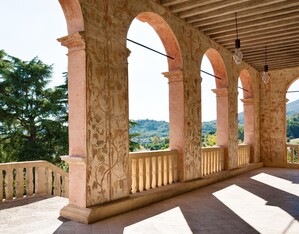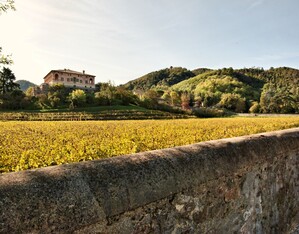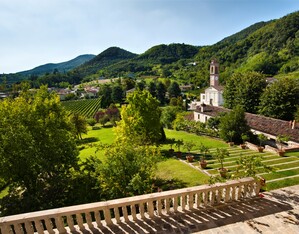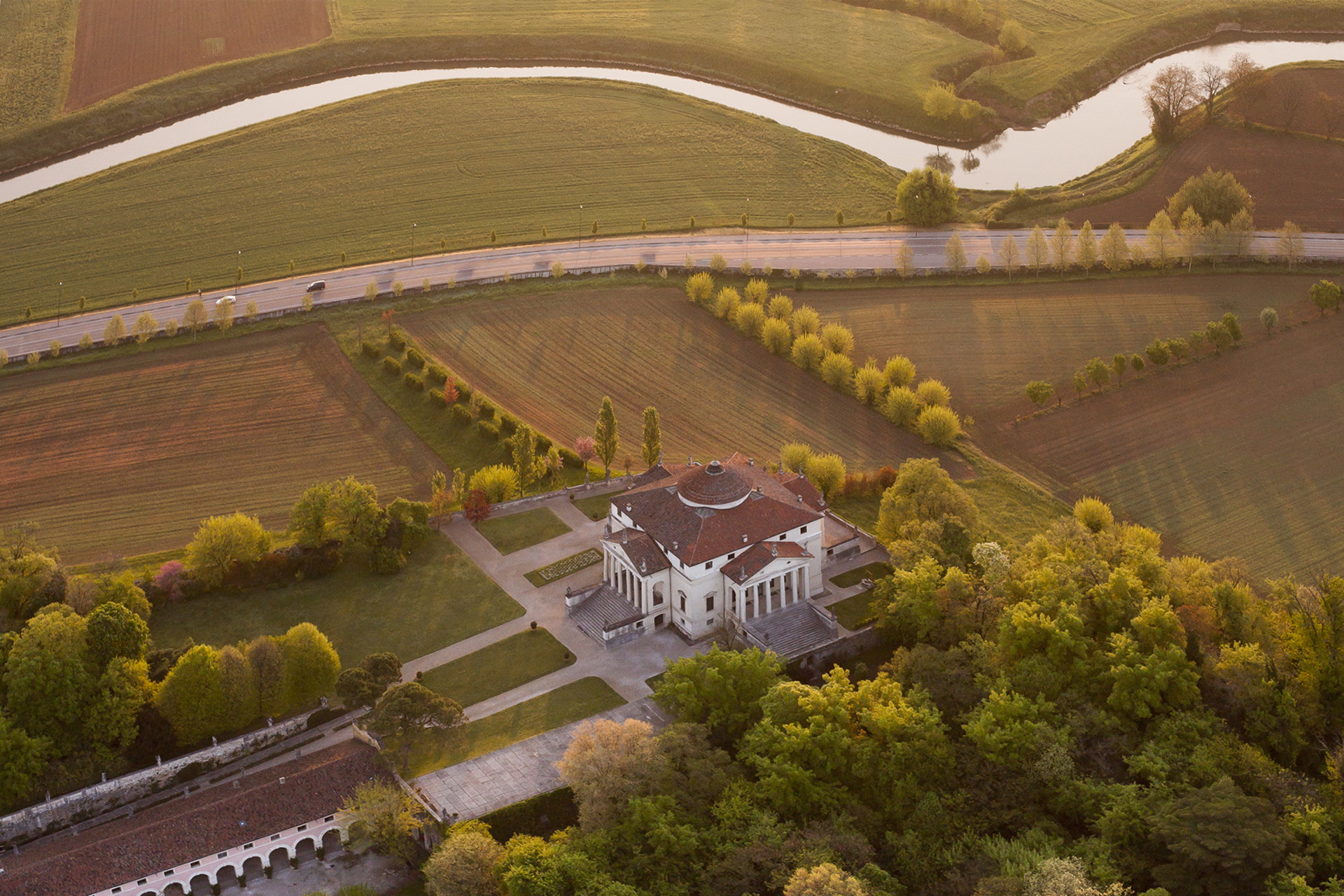In 1623, this villa was chronicled as “a most delightful place, for the Bishop of Padua a superb palace with vast gardens, fountains and other items fit for a prince”. Built in the first half of the 16th century on a small rise in the Euganean Hills, with splendid views over the surrounding natural landscape and vineyards, it has been under Fondo Ambiente Italiano ownership since 2005.
This villa was built between 1535 and 1542 as a holiday home for Francesco Pisani, Bishop of Padua. Veronese painter/architect Giovanni Maria Falconetto won the commission from Venetian patrician Alvise Cornaro, who was responsible for initiating reclamation of the Euganean Hills, supervising the works himself. The owner was keen to create an “old-fashioned” villa, bringing the classical architecture of papal Renaissance Rome to the Veneto countryside. Anticipating Palladio, he had the villa built on top of a pleasing hill, framed by spectacularly interweaving terraces and stairways to create a symbiosis between the architecture and surrounding landscape, views of which may be enjoyed from within the house thanks to its square plan and loggias. Landscape paintings inside, by Flemish painter Lambert Sustris, foster an interplay between interior and exterior, culminating in the south terrace, which is frescoed with pergolas and vine shoots. Documents from the 17th and 18th centuries attest to the fact that the villa had a garden that stretched out over the hillside. Bordered by perimeter walls that have three gateways, the entrance courtyard is arranged in a cross shape with a central fountain, and divided into four grassy squares. Recent works have restored this design, in one of the spaces maintaining a well and a centuries-old yew tree. The flower beds are bordered by a hornbeam hedge, while the south terrace now leads to a brolo orchard and vineyard. Sold in 1962 by the Paduan Curia to Vittorio Olcese, the property also has a number of rustic buildings and a small lake.
Highlights

Frescoes by Lambert Sustris
In 1542, the Flemish painter began working on an extraordinary six-room fresco cycle, in which, between pilasters, landscapes alternate with niches and figures garbed in ancient costume. Among floral decorations and fake arcades, the painted landscapes in the loggias dialogue with the real landscape outside.

Petrarch’s house at Arquà
Villa dei Vescovi is close to Francesco Petrarch’s refuge in the Euganean Hills, at Arquà, the most illustrious of the surviving ancient Venetian villas. The poet retired here in 1369, to enjoy the solitude of the gardens and landscape.

The Euganean Hills Landscape
The green hills form a central element of the villa’s structure. Indeed, it was conceived as a huge belvedere to offer sweeping views over farmed slopes and natural woodland.
Scopri di più
Paesaggi e giardini
Le oltre 4000 ville venete, costruite nell’arco di quattro secoli, hanno dato forma a un paesaggio in cui dimensione estetica e governo del territorio raggiungono una compiuta armonia.

 Villa dei Vescovi-FAI
Contacts
Villa dei Vescovi-FAI
Contacts
Contacts
Telephone:+39 049 9930473
Address
Via dei Vescovi, 4
35038, Luvigliano di Torreglia (PD)

FAI - Fondo Ambiente Italiano
 Villa dei Vescovi-FAI
Opening times and prices
Villa dei Vescovi-FAI
Opening times and prices
Opening hours
Villa dei Vescovi will be open to the public with the following opening hours:
From Friday 23 February to Sunday 29 September
From Wednesday to Sunday from 10am to 6pm (Last entry 5pm)
From Wednesday 2 October to Sunday 8 December
From Wednesday to Sunday from 10am to 5pm (Last entry 4pm)
For up-to-date visit information and to find out about extraordinary openings or closures on the occasion of holidays or special events, consult the online booking page.
We remind visitors that during the year the Villa hosts private events with possible temporary setups that could occupy some spaces in the interior and/or garden.
For reservations, ticket purchases and more information, visit the website.
Pricing
Entrance Villa dei Vescovi with free visit
- FAI members: free entrance
- Full price: € 11,00
- Reduced (6-18 years): € 4,00
- Students up to 25 years: € 4,00
- Family: € 26,00 (2 adults and 2 children 6-18 years old. From the third child onwards, each entry is free).
Entrance to Villa dei Vescovi with guided tour (Sundays only)
- FAI members: € 6,00
- Full price: € 20,00
- Reduced (6-18 years): € 10,00
- Students up to 25 years: € 10,00
Park entrance only
- FAI members: free entrance
- Full price: € 5,00
- Reduced (6-18 years): € 3,00
- Students up to 25 years: € 3,00
- Family: € 13,00
- Slot hours Friday Saturday and Sunday Park: 10 a.m. to 5:30 p.m., every 30 minutes.
Children up to 5 years old, National Trust members, Bienfaiteurs Amis du Louvre members, residents of the Municipality of Torreglia, disabled people and accompanying person: free admission.
 Villa dei Vescovi-FAI
How to get there
Villa dei Vescovi-FAI
How to get there
Address
Via dei Vescovi, 4
35038, Luvigliano di Torreglia (PD)
Latitude: 45.3432883
Longitude: 11.7092457
How to arrive by road
- Motorway A4 Milano-Venezia, exit Padova Ovest; take the ring road, Corso Australia, exit towards Colli Euganei; continue for about 10 km towards Teolo. Pass Praglia and after the roundabout take the road with the indication Luvigliano. From the tollbooth the distance is about 20 km.
- Motorway A13 Bologna-Padova, exit Terme Euganee; continue for Montegrotto Terme, Torreglia and then follow the signs. From the tollbooth the distance is about 15 km.
Cars can park in Via Roberto Ferruzzi, near the Villa. Buses can park in Piazza Mercato in Torreglia.
How to arrive by train
To reach the Villa, the reference station is Abano Terme (which is 9 km from Luvigliano di Torreglia).
- From Monday to Friday there are 10 connections with Venice/Padua and 5 on public holidays.
- For train schedules see the website.
- From the station you can take a bus (Colli AT or ATL line to the “Tito Livio 8” stop in Luvigliano di Torreglia).
How to arrive by bus
The reference company for the urban service in Padua and the extra-urban service in the spa area is Busitalia S.p.A.
- The line to follow is “Linea Colli” ATL or TL: from Padova (Stazione FS), from Abano Terme (Piazza Sacro Cuore), Montegrotto (Stazione FS).
- To consult the bus timetables visit the website.
How to arrive by bycicle
- From Montegrotto: bike path to Luvigliano. At the town of Torreglia, keep to the right always following the Strada Provinciale; the last stretch is characterized by a mixed but quiet road.
- Euganean Hills cycle path (64 km). Detour for Villa dei Vescovi; at Bresseo exit onto Via Cà Boldi and continue along Via Liviana. (3 km of mixed but quiet road).
 Villa dei Vescovi-FAI
Services/Accessibility
Villa dei Vescovi-FAI
Services/Accessibility
Services
Dogs are allowed in the park if kept on a leash, while inside the Villa only small dogs are allowed to be carried.
Villa dei Vescovi offers its guests the opportunity to stay at its facilities, immersing themselves in the magic of the Euganean Hills. Two apartments are available inside the Villa:
- The Vineyard Attic
- The Orchard Attic
Villa dei Vescovi offers its guests the opportunity to stay at its facilities, immersing themselves in the magic of the Euganean Hills. Two apartments are available inside the Villa:
- The Vineyard Attic
- The Orchard Attic
Villa dei Vescovi offers its guests the opportunity to stay at its facilities, immersing themselves in the magic of the Euganean Hills. Two apartments are available inside the Villa:
- The Vineyard Attic
- The Orchard Attic
Villa dei Vescovi offers its guests the opportunity to stay at its facilities, immersing themselves in the magic of the Euganean Hills. Two apartments are available inside the Villa:
- The Vineyard Attic
- The Orchard Attic
You can buy bottles of wine at the Enoteca Strada del Vino, open on Saturdays and Sundays from 11.00 am to 8.00 pm.
There is a parking lot in via Roberto Ferruzzi, in front of the cemetery of Luvigliano, about 400 m from the Villa (5 minutes on foot, with a slight uphill).
- GT coaches are not allowed to enter Via Vescovi: groups are advised to get off at the War Memorial and walk to the entrance of the Villa (1 minute walk, with a slight uphill climb). The drivers will have to park the coaches in Torreglia (2 km from Villa dei Vescovi) in Piazza Mercato.
- The 20-seater minibuses or 9-seater shuttles, on the other hand, can go as far as the entrance to the Villa.
The Cafeteria Bistrot "Villa dei Vescovi" is open with the following hours:
- July and August: Thursdays and Fridays from 7 pm to 11 pm, Saturdays and Sundays from 10 am to 7 pm
- September and October: Fridays, Saturdays and Sundays from 10 am to 7 pm.
- November and December: Saturdays and Sundays from 10.00 am to 5.00 pm.
The Cafeteria Bistrot "Villa dei Vescovi" is open with the following hours:
- July and August: Thursdays and Fridays from 7 pm to 11 pm, Saturdays and Sundays from 10 am to 7 pm
- September and October: Fridays, Saturdays and Sundays from 10 am to 7 pm.
- November and December: Saturdays and Sundays from 10.00 am to 5.00 pm.
The Cafeteria Bistrot "Villa dei Vescovi" is open with the following hours:
- July and August: Thursdays and Fridays from 7 pm to 11 pm, Saturdays and Sundays from 10 am to 7 pm
- September and October: Fridays, Saturdays and Sundays from 10 am to 7 pm.
- November and December: Saturdays and Sundays from 10.00 am to 5.00 pm.
The Cafeteria Bistrot "Villa dei Vescovi" is open with the following hours:
- July and August: Thursdays and Fridays from 7 pm to 11 pm, Saturdays and Sundays from 10 am to 7 pm
- September and October: Fridays, Saturdays and Sundays from 10 am to 7 pm.
- November and December: Saturdays and Sundays from 10.00 am to 5.00 pm.
The Cafeteria Bistrot "Villa dei Vescovi" is open with the following hours:
- July and August: Thursdays and Fridays from 7 pm to 11 pm, Saturdays and Sundays from 10 am to 7 pm
- September and October: Fridays, Saturdays and Sundays from 10 am to 7 pm.
- November and December: Saturdays and Sundays from 10.00 am to 5.00 pm.
The Cafeteria Bistrot "Villa dei Vescovi" is open with the following hours:
- July and August: Thursdays and Fridays from 7 pm to 11 pm, Saturdays and Sundays from 10 am to 7 pm
- September and October: Fridays, Saturdays and Sundays from 10 am to 7 pm.
- November and December: Saturdays and Sundays from 10.00 am to 5.00 pm.
The Cafeteria Bistrot "Villa dei Vescovi" is open with the following hours:
- July and August: Thursdays and Fridays from 7 pm to 11 pm, Saturdays and Sundays from 10 am to 7 pm
- September and October: Fridays, Saturdays and Sundays from 10 am to 7 pm.
- November and December: Saturdays and Sundays from 10.00 am to 5.00 pm.
The Cafeteria Bistrot "Villa dei Vescovi" is open with the following hours:
- July and August: Thursdays and Fridays from 7 pm to 11 pm, Saturdays and Sundays from 10 am to 7 pm
- September and October: Fridays, Saturdays and Sundays from 10 am to 7 pm.
- November and December: Saturdays and Sundays from 10.00 am to 5.00 pm.
The Cafeteria Bistrot "Villa dei Vescovi" is open with the following hours:
- July and August: Thursdays and Fridays from 7 pm to 11 pm, Saturdays and Sundays from 10 am to 7 pm
- September and October: Fridays, Saturdays and Sundays from 10 am to 7 pm.
- November and December: Saturdays and Sundays from 10.00 am to 5.00 pm.
Free Wi-Fi is available at Villa dei Vescovi.
It is also possible to visit the museum, a refined villa of the early 16th century inspired by classical themes and surrounded by the landscape of the Euganean Hills that dialogues with the frescoes in its rooms, creating a harmonious fusion between nature, art and architecture, between reality and illusion. The conception of the work was entrusted in the early 1500s to the nobleman Alvise Cornaro by the Bishop of Padua, Francesco Pisani, who identified here the seat for an intellectual circle gathered around the value of the landscape and its role as a stimulus for elevated thoughts and reflections. Designed by the Veronese architect Falconetto with a rigidly geometric concept, the Villa was the subject of subsequent interventions by Giulio Romano and is presented as a refined experiment in humanist culture in which architecture, art and landscape play with each other in continuous visual references in the spaces of the loggias and terraces to achieve the well-being of man.
Accessibility
The Villa is not currently accessible to the motor disabled.
Disabled visitors have free access to FAI properties open to the public by presenting their ANMIC – Associazione Nazionale Mutilati – card.
Villa dei Vescovi is accessible to people with intellectual disabilities thanks to the project “Bene FAI per tutti” (FAI property for everyone).
 Villa dei Vescovi-FAI
Private events
Villa dei Vescovi-FAI
Private events
Villa dei Vescovi offers the possibility to organize many private events. The spaces are available to host a wide variety of MICE and private events: corporate meetings, team building events, exclusive lunches and dinners, conventions, book or product presentations, guided tours and educational workshops related to the territory, volunteer projects, ceremonies, receptions and weddings. Moreover, the Villa and its park are an ideal set for photographic and cinematographic shootings.
For further information consult the website of FAI.
 Villa dei Vescovi-FAI
Itineraries
Villa dei Vescovi-FAI
Itineraries
You could find the garden in these itineraries
 Favorite saving result
Favorite saving result
 Warning!
Warning!
You've have to sign up or sign in to add this element to your favorites.
